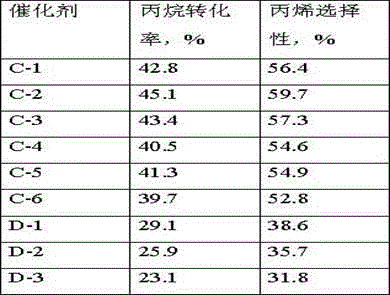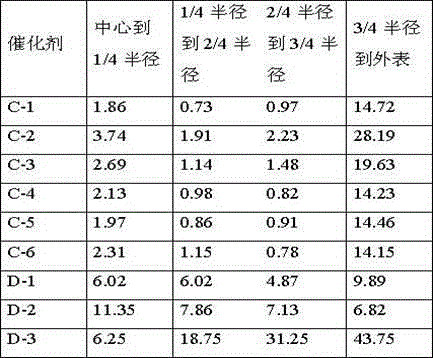Preparation method of catalyst for propane oxidative dehydrogenation to propylene
A technology for oxidative dehydrogenation and catalysts, applied in the direction of metal/metal oxide/metal hydroxide catalysts, physical/chemical process catalysts, chemical instruments and methods, etc., can solve the problem of low metal utilization in carrier channels and accelerate deep oxidation of products , the contribution of the catalyst is not large, etc., to avoid further oxidation, improve the conversion rate and selectivity of propylene, and improve the effect of utilization
- Summary
- Abstract
- Description
- Claims
- Application Information
AI Technical Summary
Problems solved by technology
Method used
Image
Examples
Embodiment 1
[0035] The spent hydrotreating catalyst (MoCo / Al 2 o 3 ), the oil on the surface of the catalyst was removed by extraction, dried at 110°C for 8h, and the obtained catalyst was calcined at 450°C for 4h to obtain the spent catalyst after treatment (containing Mo: 12.8wt%, Co: 2.3wt%, V: 2.5wt% , Ni: 1.9wt%, Al 2 o 3 : 71.2wt%), grind the catalyst to 200 mesh (means passing through a 200 mesh sieve), weigh 100 grams of powder, add 260mL of 98wt% concentrated sulfuric acid, stir at 50°C to dissolve the solid, collect the filtrate by filtration, and pour Add 54.01g of nickel nitrate to the filtrate, stir and dissolve, then add 27.31g of citric acid (the molar ratio of citric acid to Mo in the waste agent is 1), add 142.13g of pseudo-boehmite after all dissolved, and stir at 70°C until The solution was evaporated to dryness, the resulting solid was dried at 100°C for 8h, and then calcined at 600°C for 4h to obtain the catalyst precursor A, wherein Mo accounted for 6wt% of the we...
Embodiment 2
[0037] The spent hydrotreating catalyst (MoCo / Al 2 o 3 ), the oil on the surface of the catalyst was removed by extraction, dried at 110°C for 8h, and the obtained catalyst was calcined at 450°C for 4h to obtain the spent catalyst after treatment (containing Mo: 12.8wt%, Co: 2.3wt%, V: 2.5wt% , Ni: 1.9wt%, Al 2 o 3 : 71.2wt%), grind the catalyst to 200 mesh (referring to passing through a 200 mesh sieve), weigh 100 grams of powder, add 300mL of a mixed solution of 98wt% concentrated sulfuric acid and 65wt% concentrated nitric acid, the volume ratio is 2:1, in Stir at a constant temperature at 50°C to dissolve the solid, collect the filtrate by filtration, add 54.01g of nickel nitrate to the filtrate, stir and dissolve, then add 40.98g of citric acid (the molar ratio of citric acid to Mo in the waste agent is 1.5), and dissolve all Add 51.65 g of pseudo-boehmite, stir at 70°C until the solution is evaporated to dryness, dry the resulting solid at 100°C for 8 hours, and roast...
Embodiment 3
[0039] The spent hydrotreating catalyst (MoCo / Al 2 o 3 ), the oil on the surface of the catalyst was removed by extraction, dried at 110°C for 8h, and the obtained catalyst was calcined at 450°C for 4h to obtain the spent catalyst after treatment (containing Mo: 12.8wt%, Co: 2.3wt%, V: 2.5wt% , Ni: 1.9wt%, Al 2 o 3 : 71.2wt%), grind the catalyst to 200 mesh (referring to passing through a 200 mesh sieve), weigh 100 grams of powder, add 450mL of a mixed solution of 35wt% concentrated hydrochloric acid and 65wt% concentrated nitric acid, and the volume ratio is 1:1. Stir at a constant temperature at 50°C to dissolve the solid, collect the filtrate by filtration, add 54.01g of nickel nitrate to the filtrate, stir to dissolve, add 13.66g of citric acid (the molar ratio of citric acid to Mo in the waste agent is 0.5), and dissolve all Add 447g of pseudo-boehmite, stir at 70°C until the solution is evaporated to dryness, dry the obtained solid at 100°C for 8 hours, and roast at 6...
PUM
 Login to View More
Login to View More Abstract
Description
Claims
Application Information
 Login to View More
Login to View More - R&D
- Intellectual Property
- Life Sciences
- Materials
- Tech Scout
- Unparalleled Data Quality
- Higher Quality Content
- 60% Fewer Hallucinations
Browse by: Latest US Patents, China's latest patents, Technical Efficacy Thesaurus, Application Domain, Technology Topic, Popular Technical Reports.
© 2025 PatSnap. All rights reserved.Legal|Privacy policy|Modern Slavery Act Transparency Statement|Sitemap|About US| Contact US: help@patsnap.com


